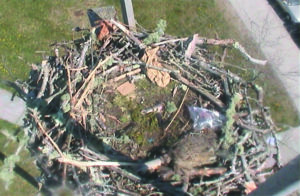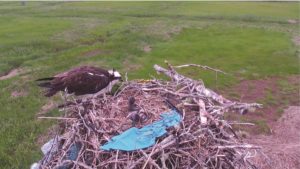Come April, ospreys — the large raptors also known as sea hawks — make their thousands-of-miles-long journeys from South America back to Cape Cod to nest. A peek inside their unique homes, which can be seen sitting at the tops of utility poles, chimneys, and docks, reveals that the birds’ returns are accompanied by annual home improvements.
Osprey nests, occupied by the same pairs year after year, are revamped with fresh sticks, bark, sod, grasses, algae, and other original decorative items that they find around town.
“You’d be surprised,” says Joan Damore of Hyannis, a devoted osprey-watcher, about the other items they add to their décor. “They collect flip-flops, T-shirts, or really any kind of clothing. One Memorial Day, one nest had a flag built into the nest, probably taken from a cemetery. I’ve also seen golf clubs, golf balls, and rosary beads,” she adds.
Damore began observing ospreys when a pair built a nest at Dennis-Yarmouth Regional High School, where she worked as an administrative assistant. She named them Dennis and Yvonne.
Now retired, Damore keeps tabs on nest interiors online by watching the two live “osprey cams” on the Cape. One, sponsored by the MIT Club of Cape Cod, is set up to observe a nest at Barnstable High School; the other is at the Cape Cod Museum of Natural History in Brewster.

The return of the ospreys is an event, and a harbinger of spring, says Kate Roderick, digital manager at the museum. Roderick oversees the osprey cam installed 16 years ago, and during that time she has seen the nest outfitted with T-shirts, plastic bags, and pieces of tarp. Her favorite find, though, was a Barbie. “It was quite a sight to see that small blonde head peeking out,” she says.
Throughout the season, from April to September, the birds are always redecorating, and sometimes the pair, who mate for life, bicker over where things should go, Roderick says.
“If you watch them for long enough, you’ll see the female come and put a stick in,” she says. “The male will come and move it. The female will come and put it back. They’re very particular birds.”
The Cape is not the ospreys’ only destination. They fly from winter homes in Brazil and Venezuela by way of Cuba to return to summer places along the Eastern seaboard from the Carolinas to Maine.
Other osprey populations can be traced across the globe, from Africa to Europe to Asia, says Mark Faherty, the science coordinator at Mass Audubon’s Wellfleet Bay Wildlife Sanctuary.
About 60 years ago, the once robust North American population of ospreys was nearing extinction because of DDT, a pesticide that was widely used on crops until it was banned in 1972. The chemical caused birds’ eggshells to thin, Faherty explains.
After ospreys were listed under the Mass. Endangered Species Act, nesting platforms were put up and hatching programs were developed in which eggs and chicks from ospreys along the Connecticut River were brought to Massachusetts. “The population has grown exponentially in the last 10 to 20 years,” says Faherty, who puts the current number of nests on the Cape at about 400. Their recovery, he says, is viewed as “a success story of the modern environmental movement.”

Faherty has seen his share of weird items in bird nests. “It’s just what they do,” he says. Some birds, he says, like Australia’s bowerbirds, are connoisseurs of color, sticking to one hue as they decorate their nests. “Ospreys,” though, “are known packrats,” Faherty says. He has seen everything from candy wrappers to cassette tapes and a fishing rod in their nests.
When he gives presentations on these birds, he says, he likes to include a picture taken a few years ago of a nest outfitted with a whisk broom. “It’s like they kept it for tidying up,” Faherty says. “It’s funny, because it was a really messy nest.”
Barry Powers, a manager of the asphalt supplier Aggregate Industries in South Dennis, works alongside a massive 300-pound osprey nest.
Powers and his team weighed the nest in 2013, using their truck scales and a pallet, when they moved it because the concrete plant it had been built on was preparing to go into production. They placed it on a pole they built especially for the nest. “We wanted to make sure the ospreys still had somewhere safe to go,” he says.
Powers’s team installed a camera for nest-watching but ended up taking it down. What they saw, he says, “was the Wild Kingdom version” of osprey life, “not the Disney version.” Two of four chicks did not make it, he explains: one starved, he said, and the chicks pecked the other one to death.
Theirs wasn’t the only osprey cam to go offline. One at the Woods Hole Oceanographic Institution was taken down in 2016 after a rare case of an abusive mother osprey caused an uproar among bird-watchers. “It was the kind of thing that people don’t get,” says Faherty. “Animals can be bad parents, too.”

Powers is still fond of the ospreys that nest near his work. “They come in,” he says. “They eat on top of our silos, throw up the fish guts, and it smells like fish. They poop on our plant. But, yeah, we’re happy.”
As the osprey population has risen on the Cape, nests have shown up on utility poles, which Faherty says has led to complications, from power outages to fires that have burned nests and killed chicks.
While people like Powers and groups like the Osprey Project in Falmouth have built alternative structures for the birds to nest on, Eversource only recently began finding ways to address the problems caused by the birds on their utility lines, Faherty says. The company now has a website with information on how it manages ospreys on utility poles, with frequently asked questions and an email contact for people who see problem nests on utility lines. “It’s not perfect,” Faherty says, but “things are now much better in terms of communication and expectations.”
While the densest population of nests is up Cape, more nests are appearing each year on poles on the Outer Cape, including, Faherty says, two in Truro (one on the tower at the dump and another on a pole erected by Mass Audubon at Corn Hill) and two in Wellfleet (one on Chequessett Neck Road, near the golf course, and another at the town pier).



